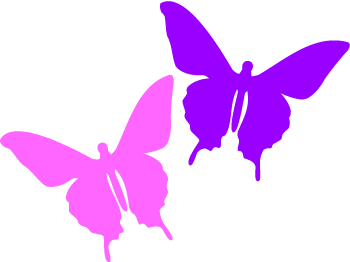1 - Batesian Mimicry
What Is Batesian Mimicry?
In Batesian mimicry, as it applies to insects, an edible insect looks similar to an aposematic, (inedible insect). The inedible insect is referred to as the model, and the lookalike species is referred to as the mimic. Hungry predators that have tried to eat the unpalatable (aposematic) model species learn to associate its colors and markings with an unpleasant eating experience. The predator will subsequently avoid wasting time and energy catching an inedible meal again. Because the mimic resembles the model, it benefits from the predator's bad experience.
Successful Batesian mimicry species depend on an imbalance of unpalatable versus edible species. The mimics must be limited in number, while the models need to to be common and abundant. For such a defensive strategy to work for the mimic, there must be a high probability that the predator in the equation will first attempt to eat the inedible model species. Having learned to avoid such foul-tasting meals, the predator will leave both the models and mimics alone. When tasty mimics become abundant, predators take longer to develop an association between the bright colors and the indigestible meal.
Birds avoid the unpalatable Monarch butterfly, which accumulates toxic steroids called cardenolides in its body from feeding on milkweed plants as a caterpillar. The Viceroy butterfly bears similar colors as the Monarch, so birds avoid Viceroys, too. While Monarchs and Viceroys have long been used as a classic example of Batesian mimicry, some entomologists now argue they are really a case of Müllerian mimicry.
2 - Müllerian Mimicry
What Is Mullerian Mimicry?
A form of protective mimicry in which two or more poisonous or inedible species closely resemble each other and are therefore avoided equally by all their natural predators.
The similarity in coloration between the Monarch and Viceroy butterflies, once considered an example of Batesian mimicry, is now generally considered as Müllerian mimicry because the Viceroy is thought to be as bad-tasting to birds as the Monarch.
Müllerian mimicry is named for the German-born Brazilian zoologist Fritz Müller (1821-97).
3 - Aposematic Coloration
What is Aposematic Coloration - (or warning coloration)
Aposematic coloration is the bright, attention-getting coloration that protects an organism from experienced predators (i.e., predators who have previously eaten a similar-looking animal and have gotten sick from it). Both poisonous organisms (like the Monarch butterfly) and its mimics (poisonous or not) are said to have aposematic coloration.
4 - Monomorphism
What is monomorphism?
Monomorphism means having only one form (butterfly species having sexes that are similar in size and appearance,) and dimorphism means there are only two forms, typically male and female.
5 - Polymorphism
What is polymorphism?
In biology, polymorphism is defined as a discontinuous genetic variation
resulting in the occurrence of several different forms or types of individuals among the members of a single species. A discontinuous genetic variation divides the individuals of a population into two or more sharply distinct forms. The most obvious example of this is the separation of most higher organisms into male and female sexes.
Mocker Swallowtail females are a prime example of a polymorphic butterfly species. They can exhibit any of fourteen combinations of colors and patterns, whereas the males have only one color and pattern.
( No images available )
6 - Gynandromorphism
What is Gynandromorphism?
A gynandromorph is an organism that contains both male and female characteristics. The term comes from the Greek γυνή (gynē), female, ἀνήρ (anēr), male, and μορφή (morphē), form, and is used mainly in the field of entomology.
Lacewing butterflies (Cethosia ceyane) are an example of butterflies that have instances of gynandromorphism within their species.









